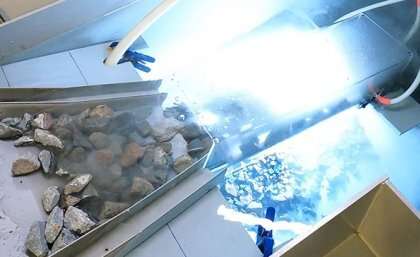Date: 14th May 2024
Media - COEMinerals researchers & a High-voltage technology invention set to 'supercharge the mining industry' featured by multiple media outlets including Channel 7 Brisbane

–
https://www.globalminingreview…

High-voltage technology to supercharge the mining industry
Published by Jane Bentham, Tuesday, 14 May 2024 14:00
Zapping rocks with a high-voltage pulse – similar to a lightning strike – could be the answer to decarbonising the mining industry, according to researchers from The University of Queensland.

Researchers from UQ’s Sustainable Minerals Institute have developed and are commercialising High Voltage Pulse (HVP) technology, which uses a short-pulsed discharge similar to a lightning strike, to selectively break mineralised ores while keeping barren rocks intact.
Project leader Dr Christian Antonio said their HVP technology, in the process of being commercialised, could significantly reduce energy consumption and essentially help decarbonise the mining industry.
“Mineral processing is the most energy intensive part of mining and is a significant consumer of energy globally,” Dr Antonio explained.
“This technology makes it possible to choose the material which should go to the processing plant and leave behind material which contains little or no metal.
“By separating ‘barren’ rocks from the valuable mineralised rocks, which are weakened by the lightning strikes, we can cut down processing time and make the whole process more energy efficient.
“These efficiencies are noticeable throughout the mining process but, in the grinding stage in particular, our research has shown a reduction of approximately 30% in processing time and energy consumption.”
Dr Antonio said the concept behind HVP technology was similar to lightning attractors – or how lightning was more likely to strike someone holding a metallic umbrella.
“Electrical energy automatically targets the conductive mineral particles within a rock and breaks up the rock as it makes its way to them,” he added.
“To deliver this energy we also electrify a conventional piece of mineral processing equipment that sorts rocks by size, meaning we are simultaneously zapping the rocks and sorting the fragments.
“This is a more efficient way to deliver the energy while achieving the over 100 tph throughputs required by the mining industry.”
HVP technology is one of the main focuses of UQ’s Julius Kruttschnitt Mineral Research Centre’s Separation Group, which develops mineral separation processes that improve profitability and minimise environmental impact.
Group Leader Associate Professor Kym Runge said there was wide industry interest in how the technology could decarbonise operations.
“A key part of this project is showing our partners that the technology can feasibly be added to their plants,” Associate Professor Runge commented.
“We are currently working on building a business case that will quantify the benefits of this technology, then we will design a HVP unit integrating our technology and progress that to commercialisation.
“Ultimately the plan is to build a pilot plant and demonstrate the benefits of HVP at one of our sponsor’s sites.”
–
https://knowridge.com/2024/05/…

New high-voltage technology could supercharge the mining industry
By University of Queensland ‑May 16, 2024

Zapping rocks with a high-voltage pulse — similar to a lightning strike — could be the answer to decarbonizing the mining industry according to researchers from The University of Queensland.
Researchers from UQ’s Sustainable Minerals Institute have developed high voltage pulse (HVP) technology, which uses a short-pulsed discharge similar to a lightning strike, to selectively break mineralized ores while keeping barren rocks intact.
Project leader Dr. Christian Antonio said their HVP technology, in the process of being commercialized, could significantly reduce energy consumption and essentially help decarbonize the mining industry.
“Mineral processing is the most energy intensive part of mining and is a significant consumer of energy globally,” Dr. Antonio said.
“This technology makes it possible to choose the material which should go to the processing plant and leave behind material which contains little or no metal.
“By separating ‘barren’ rocks from the valuable mineralized rocks, which are weakened by the lightning strikes, we can cut down processing time and make the whole process more energy efficient.
“These efficiencies are noticeable throughout the mining process but, in the grinding stage in particular, our research has shown a reduction of approximately 30% in processing time and energy consumption.”
Dr. Antonio said the concept behind HVP technology was similar to lightning attractors — or how lightning was more likely to strike someone holding a metallic umbrella.
“Electrical energy automatically targets the conductive mineral particles within a rock and breaks up the rock as it makes its way to them,” he said.
“To deliver this energy we also electrify a conventional piece of mineral processing equipment that sorts rocks by size, meaning we are simultaneously zapping the rocks and sorting the fragments.
“This is a more efficient way to deliver the energy while achieving the over 100 ton per hour throughputs required by the mining industry.”
HVP technology is one of the main focuses of UQ’s Julius Kruttschnitt Mineral Research Center’s Separation Group, which develops mineral separation processes that improve profitability and minimize environmental impact.
Group Leader Associate Professor Kym Runge said there was wide industry interest in how the technology could decarbonize operations.
“A key part of this project is showing our partners that the technology can feasibly be added to their plants,” Associate Professor Runge said.
“We are currently working on building a business case that will quantify the benefits of this technology, then we will design a HVP unit integrating our technology and progress that to commercialization.
“Ultimately the plan is to build a pilot plant and demonstrate the benefits of HVP at one of our sponsor’s sites
–
https://techxplore.com/news/20…

High-voltage technology to supercharge the mining industry

Zapping rocks with a high-voltage pulse — similar to a lightning strike — could be the answer to decarbonizing the mining industry according to researchers from The University of Queensland.
Researchers from UQ’s Sustainable Minerals Institute have developed high voltage pulse (HVP) technology, which uses a short-pulsed discharge similar to a lightning strike, to selectively break mineralized ores while keeping barren rocks intact.
Project leader Dr. Christian Antonio said their HVP technology, in the process of being commercialized, could significantly reduce energy consumption and essentially help decarbonize the mining industry.
“Mineral processing is the most energy intensive part of mining and is a significant consumer of energy globally,” Dr. Antonio said.
“This technology makes it possible to choose the material which should go to the processing plant and leave behind material which contains little or no metal.
“By separating ‘barren’ rocks from the valuable mineralized rocks, which are weakened by the lightning strikes, we can cut down processing time and make the whole process more energy efficient.
“These efficiencies are noticeable throughout the mining process but, in the grinding stage in particular, our research has shown a reduction of approximately 30% in processing time and energy consumption.”
Dr. Antonio said the concept behind HVP technology was similar to lightning attractors — or how lightning was more likely to strike someone holding a metallic umbrella.
“Electrical energy automatically targets the conductive mineral particles within a rock and breaks up the rock as it makes its way to them,” he said.
“To deliver this energy we also electrify a conventional piece of mineral processing equipment that sorts rocks by size, meaning we are simultaneously zapping the rocks and sorting the fragments.
“This is a more efficient way to deliver the energy while achieving the over 100 ton per hour throughputs required by the mining industry.”
HVP technology is one of the main focuses of UQ’s Julius Kruttschnitt Mineral Research Center’s Separation Group, which develops mineral separation processes that improve profitability and minimize environmental impact.
Group Leader Associate Professor Kym Runge said there was wide industry interest in how the technology could decarbonize operations.
“A key part of this project is showing our partners that the technology can feasibly be added to their plants,” Associate Professor Runge said.
“We are currently working on building a business case that will quantify the benefits of this technology, then we will design a HVP unit integrating our technology and progress that to commercialization.
“Ultimately the plan is to build a pilot plant and demonstrate the benefits of HVP at one of our sponsor’s sites.”
—
https://resourcesreview.com.au…

Resources Review (17 May, 2024)
UQ researchers develop high voltage pulse technology to decarbonise mining industry
Researchers from The University of Queensland’s Sustainable Minerals Institute have developed an innovative High Voltage Pulse (HVP) technology that could revolutionise the mining industry by significantly reducing energy consumption and aiding decarbonisation efforts.
The HVP technology employs a short-pulsed discharge similar to a lightning strike to selectively break down mineralised ores while leaving barren rocks intact.
This method, currently in the process of commercialisation, promises substantial energy savings in mineral processing.
Project leader Dr Christian Antonio highlighted the potential of HVP technology to cut down energy use in the mining industry, particularly during the grinding stage, where a reduction of about 30 per cent in processing time and energy consumption has been observed.
“Mineral processing is the most energy-intensive part of mining and is a significant consumer of energy globally.
“This technology makes it possible to choose the material that should go to the processing plant and leave behind material that contains little or no metal.
“By separating ‘barren’ rocks from the valuable mineralised rocks, which are weakened by the lightning strikes, we can cut down processing time and make the whole process more energy efficient,” Dr Antonio explained.
The technology works by targeting conductive mineral particles within rocks, breaking them up with electrical energy similar to how lightning strikes a metallic object.
By integrating HVP technology with conventional mineral processing equipment, rocks are simultaneously zapped and sorted by size, achieving the high throughput required by the mining industry.
HVP technology is a key focus of UQ’s Julius Kruttschnitt Mineral Research Centre’s Separation Group, which aims to improve profitability and minimise the environmental impact of mineral separation processes.
Group Leader Associate Professor Kym Runge noted the wide industry interest in the technology’s decarbonisation potential.
“We are currently working on building a business case that will quantify the benefits of this technology, then we will design a HVP unit integrating our technology and progress that to commercialisation,” said Associate Professor Runge.
This research is supported by the Resources Technology and Critical Minerals Trailblazer program, alongside industry partners including Newmont and JKTech.
The collaboration aims to bring HVP technology from the lab to commercial mining operations, contributing to a more sustainable future for the industry.
—
https://www.uq.edu.au/news/art…
UQ News
Zapping rocks with a high-voltage pulse – similar to a lightning strike – could be the answer to decarbonising the mining industry according to researchers from The University of Queensland.
Researchers from UQ’s Sustainable Minerals Institute have developed High Voltage Pulse (HVP) technology, which uses a short-pulsed discharge similar to a lightning strike, to selectively break mineralised ores while keeping barren rocks intact.
Project leader Dr Christian Antonio said their HVP technology, in the process of being commercialised, could significantly reduce energy consumption and essentially help decarbonise the mining industry.
“Mineral processing is the most energy intensive part of mining and is a significant consumer of energy globally,” Dr Antonio said.
“This technology makes it possible to choose the material which should go to the processing plant and leave behind material which contains little or no metal.
“By separating ‘barren’ rocks from the valuable mineralised rocks, which are weakened by the lightning strikes, we can cut down processing time and make the whole process more energy efficient.
“These efficiencies are noticeable throughout the mining process but, in the grinding stage in particular, our research has shown a reduction of approximately 30 per cent in processing time and energy consumption.”
Dr Antonio said the concept behind HVP technology was similar to lightning attractors – or how lightning was more likely to strike someone holding a metallic umbrella.
“Electrical energy automatically targets the conductive mineral particles within a rock and breaks up the rock as it makes its way to them,” he said.
“To deliver this energy we also electrify a conventional piece of mineral processing equipment that sorts rocks by size, meaning we are simultaneously zapping the rocks and sorting the fragments.
“This is a more efficient way to deliver the energy while achieving the over one hundred tonne per hour throughputs required by the mining industry.”
HVP technology is one of the main focuses of UQ’s Julius Kruttschnitt Mineral Research Centre’s Separation Group, which develops mineral separation processes that improve profitability and minimise environmental impact.
Group Leader Associate Professor Kym Runge said there was wide industry interest in how the technology could decarbonise operations.
“A key part of this project is showing our partners that the technology can feasibly be added to their plants,” Associate Professor Runge said.
“We are currently working on building a business case that will quantify the benefits of this technology, then we will design a HVP unit integrating our technology and progress that to commercialisation.
“Ultimately the plan is to build a pilot plant and demonstrate the benefits of HVP at one of our sponsor’s sites.”
This research is funded through the Resources Technology and Critical Minerals Trailblazer program, which also has the support of several mining industry partners, including Newmont and JKTech.
Images and video available.
–
https://industryqld.com.au/res…

UQ advances ‘lightning’ solution for processing
14 May 2024
Zapping rocks with a high-voltage pulse – similar to a lightning strike – could be the answer to decarbonising the mining industry, according to researchers from The University of Queensland.Researchers from UQ’s Sustainable Minerals Institute are commercialising High Voltage Pulse (HVP) technology, which uses a short-pulsed discharge to selectively break mineralised ores while keeping barren […]

